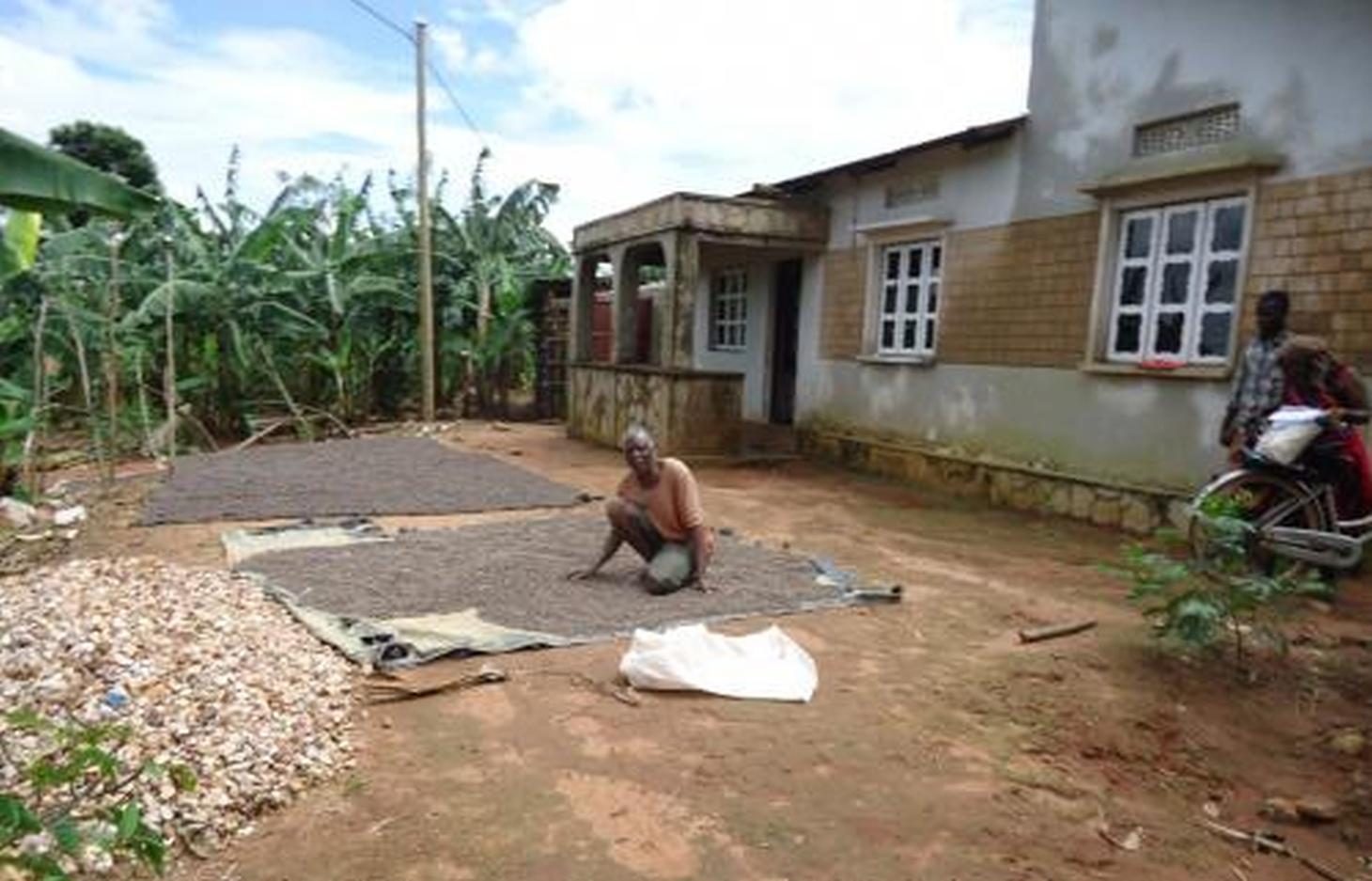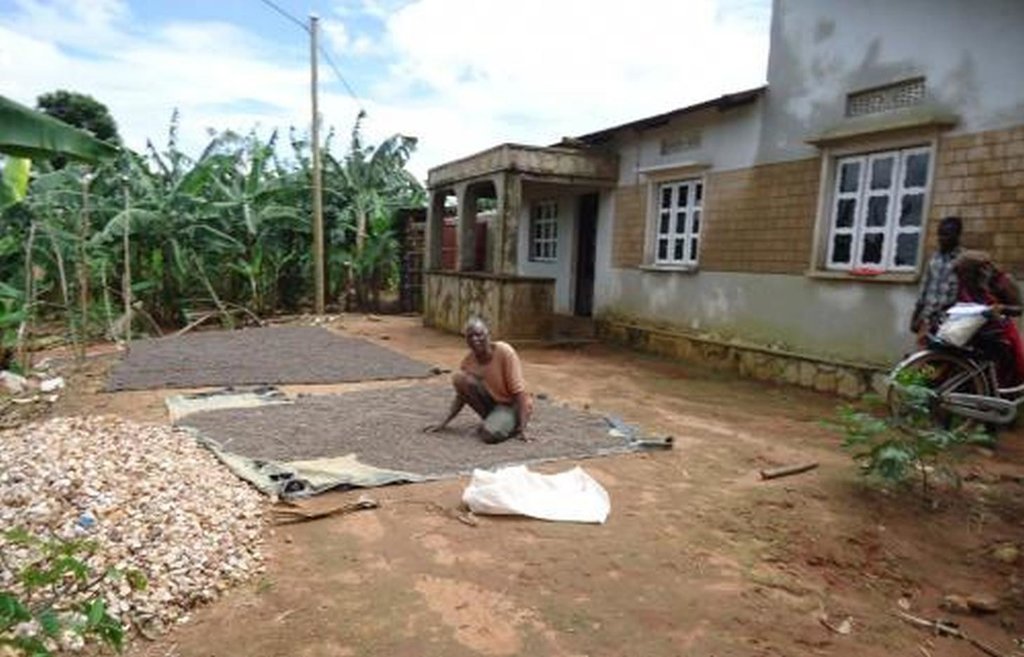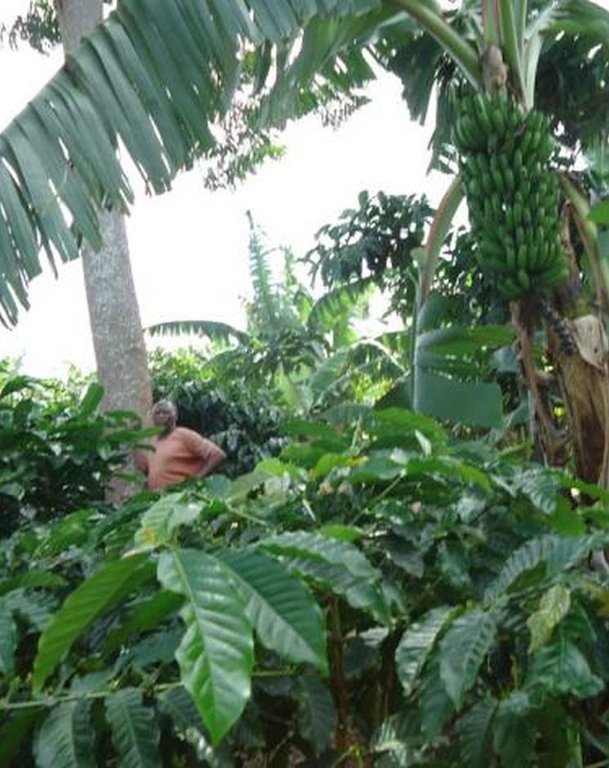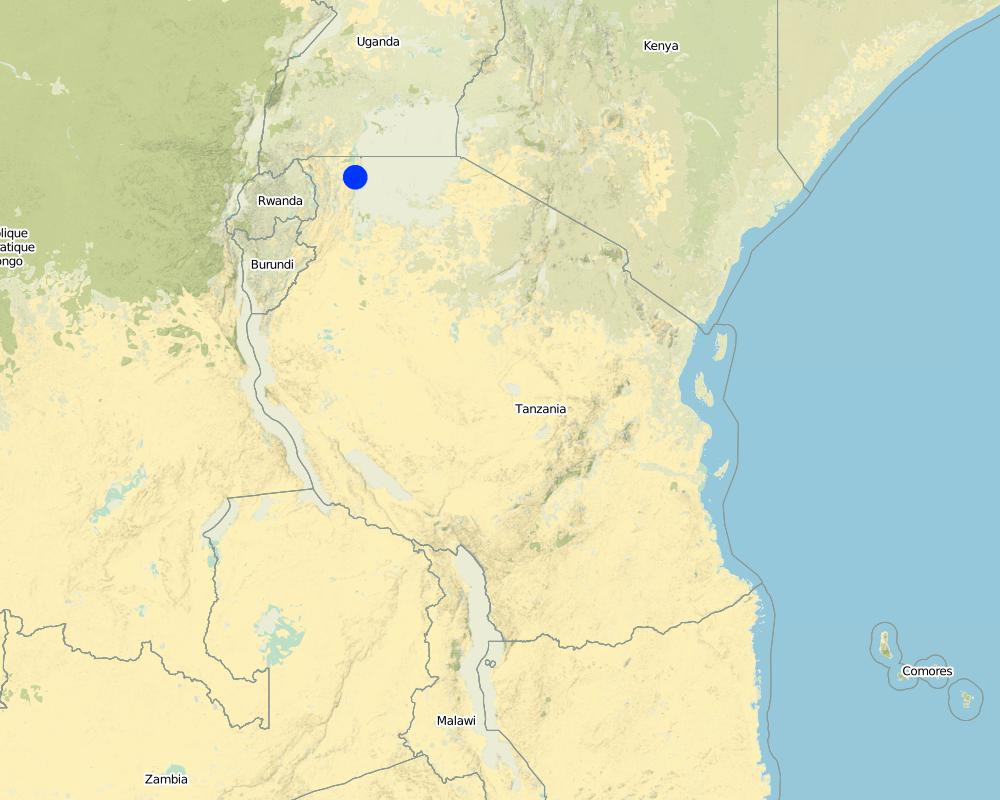Buhaya agroforestry system [Tanzania, United Republic of]
- Creation:
- Update:
- Compiler: Godfrey Baraba
- Editor: –
- Reviewers: David Streiff, Alexandra Gavilano
Ekibanja (Kihaya)
technologies_1177 - Tanzania, United Republic of
View sections
Expand all Collapse all1. General information
1.2 Contact details of resource persons and institutions involved in the assessment and documentation of the Technology
SLM specialist:
Government :
Government :
Mashauri Babylus
Bukoba DC
Tanzania, United Republic of
Government :
Rutatatinisibwa Dominick
Bukoba DC
Tanzania, United Republic of
Government :
Rwezaula Raphael
Bukoba DC
Tanzania, United Republic of
SLM specialist:
Kaihura Fidelis
K-TAMP
Tanzania, United Republic of
land user:
Shaaban Habibu
Kyema village farmer
Tanzania, United Republic of
Name of project which facilitated the documentation/ evaluation of the Technology (if relevant)
The Transboundary Agro-ecosystem Management Project for the Kagera River Basin (GEF-FAO / Kagera TAMP )Name of the institution(s) which facilitated the documentation/ evaluation of the Technology (if relevant)
FAO Food and Agriculture Organization (FAO Food and Agriculture Organization) - ItalyName of the institution(s) which facilitated the documentation/ evaluation of the Technology (if relevant)
Bukoba district council (Bukoba district council) - Tanzania, United Republic of1.3 Conditions regarding the use of data documented through WOCAT
The compiler and key resource person(s) accept the conditions regarding the use of data documented through WOCAT:
Yes
1.5 Reference to Questionnaire(s) on SLM Approaches (documented using WOCAT)
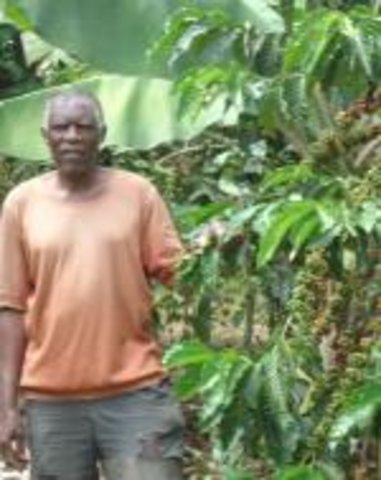
Indigenous knowledge transfer [Tanzania, United Republic of]
Indigenous knowledge transfer, is a common phenomena in farming societies whereby elders taught younger generations the practical aspects in production and emphasizes the norms and proms in folk story tales.
- Compiler: Godfrey Baraba
2. Description of the SLM Technology
2.1 Short description of the Technology
Definition of the Technology:
Traditional agroforestry system comprising mixture of banana, coffee, fruit trees, biannual crops, annual crops and timber trees which together optimize the use of soil, moisture and space.
2.2 Detailed description of the Technology
Description:
Buhaya agro forest system is a mix of annual and perennial crops together with trees and shrubs are densely planted on a restricted area usually 0.5 -2ha per household to increase crop yield, wood production and conserve soil and water. Buhaya agro forest system is applied on individual owned land specific at home steady. In this technology a plot of 1ha comprises of :
1.Perennial crops (coffee, banana, ) on average (10,000/36 coffee plants can be planted in one hector randomly in the alternating manner with banana, 10,000/25 banana stools) can be planted in 1ha randomly in the alternating manner with coffee.
2.Annual and biannual crops (eg. Maize, beans, cassava, sweet potatoes, yams etc) are planted in the between spaces. Maize and beans are planted twice in the short (Masika) and long rains (Vuli) where tubers are planted at any time throughout the year.
3.Trees and shrubs (eg. Makkhamia spps, Maesopsis and migorora). Trees are planted along the boundaries spaced at an average of 15m to act as wind break and timber production. Shrubs are planted at closed distance in between trees to act as live fence.
Buhaya agro forest system was practiced since early 1900. Application of farmyard manures and crop residue mulch are the supportive measures. The land owners keep small livestock/ few cattle under zero grazing to obtain manure for soil fertility improvem
Purpose of the Technology: The purposes for applying the technology is to control soil erosion and nutrient improvement.
Establishment / maintenance activities and inputs: The establishment of Buhaya agro forest system is done on a virgin land starting in the dry season July to September and it normally takes 2-5years by doing the following activities.
1.To prepare the land by cutting, removing/burning shrubs and grasses followed by land tillage. This is the difficult job and sometimes it can force the farmer to plant annual crops before planting perennial crops due to inadequate preparation time.
2.To dig holes of different size according to what crop is meant for in the alternating manner. This activity is done after harvesting annual crops in shot rainfalls (March to June).
3.To plant banana in July and August followed by coffee in September to November and March to May next year.
4.To plant trees along the boundaries followed by planting shrubs between the trees spacing to create a live fence.
5.To plant cassava, yams, pawpaw, avocados and mangoes. These are planted randomly and in a few quantity.
The maintenance of Buhaya agro forest system is the simple but tidies job requires all the year to be working in the garden. The required activities are
1.To weed the field as preparation for planting seasonal crops( i.e maize and beans) twice per year in dry seasons.
2.To remove unwanted banana suckers (desuckering) and harvested banana stems in order to maintain a required number of plants( mother, daughter and grand daughter) per stool. This requires a lot of time for assessing the plant health as well as spacing.
3.To plant and harvest maize and beans twice per year.
4.To prune coffee trees, harvest coffee cherry, dry, and market them once per year.
5.To replace harvested cassava and yams as required.
2.3 Photos of the Technology
2.5 Country/ region/ locations where the Technology has been applied and which are covered by this assessment
Country:
Tanzania, United Republic of
Region/ State/ Province:
Tanzania
Further specification of location:
Bukoba District (Kyema village)
Specify the spread of the Technology:
- evenly spread over an area
If precise area is not known, indicate approximate area covered:
- 1-10 km2
Map
×2.6 Date of implementation
If precise year is not known, indicate approximate date:
- more than 50 years ago (traditional)
2.7 Introduction of the Technology
Specify how the Technology was introduced:
- as part of a traditional system (> 50 years)
Comments (type of project, etc.):
It is said that in 1939 after second world war there was a hunger in Bukoba which forced people to plant banana instead of the traditional cropping of sorghum and millet. During the British colonial people were forced to cultivate coffee; as well health services introduced by Christian missionaries increased the population growth which revealed pressure on land and forced to opt agro forest.
3. Classification of the SLM Technology
3.1 Main purpose(s) of the Technology
- protect a watershed/ downstream areas – in combination with other Technologies
3.2 Current land use type(s) where the Technology is applied
Land use mixed within the same land unit:
Yes
Specify mixed land use (crops/ grazing/ trees):
- Agroforestry

Cropland
- Annual cropping
- Perennial (non-woody) cropping
- Tree and shrub cropping
Annual cropping - Specify crops:
- cereals - maize
- legumes and pulses - beans
- root/tuber crops - sweet potatoes, yams, taro/cocoyam, other
Perennial (non-woody) cropping - Specify crops:
- banana/plantain/abaca
Tree and shrub cropping - Specify crops:
- coffee, open grown
- fruits, other
- Makkhamia spps, Maesopsis and Migorora
Number of growing seasons per year:
- 2
Specify:
Longest growing period in days: 120; Longest growing period from month to month: September to December; Second longest growing period in days: 65; Second longest growing period from month to month: March to May

Grazing land
Animal type:
- cattle - non-dairy working
Comments:
Major land use problems (compiler’s opinion): The major land use problem was soil erosion and excessive nutrient mining
Major land use problems (land users’ perception): Limited suitable land for cropping in the area
Future (final) land use (after implementation of SLM Technology): Mixed: Mf: Agroforestry
3.4 Water supply
Water supply for the land on which the Technology is applied:
- rainfed
3.5 SLM group to which the Technology belongs
- agroforestry
3.6 SLM measures comprising the Technology

agronomic measures
- A1: Vegetation/ soil cover

vegetative measures
- V1: Tree and shrub cover
- V2: Grasses and perennial herbaceous plants

management measures
- M1: Change of land use type
Comments:
Secondary measures: agronomic measures
Type of vegetative measures: scattered / dispersed
3.7 Main types of land degradation addressed by the Technology

soil erosion by water
- Wt: loss of topsoil/ surface erosion

chemical soil deterioration
- Cn: fertility decline and reduced organic matter content (not caused by erosion)
Comments:
Main causes of degradation: soil management (cultivation along the slopes versus across the slopes.), crop management (annual, perennial, tree/shrub) (Routeenly harvests without fertilization implies permanent removal of nutriets.), Heavy / extreme rainfall (intensity/amounts) (average rainfall 1,200mm on slopes), other natural causes (avalanches, volcanic eruptions, mud flows, highly susceptible natural resources, extreme topography, etc.) specify (Sandstone parent material), education, access to knowledge and support services (Inadequate extension services)
Secondary causes of degradation: poverty / wealth (Limited household income to invest in sustainable land management), labour availability (Labour force dominated by the elderly)
3.8 Prevention, reduction, or restoration of land degradation
Specify the goal of the Technology with regard to land degradation:
- prevent land degradation
- reduce land degradation
Comments:
Secondary goals: mitigation / reduction of land degradation
4. Technical specifications, implementation activities, inputs, and costs
4.1 Technical drawing of the Technology
Technical specifications (related to technical drawing):
Overview of the Buhaya agroforestry system. Average of 5m spacing between banana plants then alternate with coffee after two stools. Cassava and yams scattered at the space after 6 to 10 stools. beans and maize are planted in the left space to make sure all soil surface is covered. Long trees (Maesopsis spps) spaced at 10m.
Location: Kyema village. Bukoba/Kagera/Tanzania
Date: 22 MAY 2012
Technical knowledge required for field staff / advisors: moderate (The importance of diversification for income stabilization.)
Technical knowledge required for land users: moderate (Trees can improve income generating and assure food security in the sense of food accessibility.)
Main technical functions: improvement of ground cover, increase in organic matter, increase in nutrient availability (supply, recycling,…)
Secondary technical functions: control of raindrop splash, control of dispersed runoff: retain / trap, stabilisation of soil (eg by tree roots against land slides), increase of infiltration, increase / maintain water stored in soil, reduction in wind speed
Scattered / dispersed
Vegetative material: T : trees / shrubs, F : fruit trees / shrubs, C : perennial crops, O : other
Trees/ shrubs species: Makhamia spp, Maesopsis eminii are planted
Fruit trees / shrubs species: Mangifera indica, Carica papaya, Persia americana are planted
Perennial crops species: Musa spp are planted
Change of land use type: Change from cropland (Annual and biannual crop production eg. millet, sorghum and beans) to Aggro forest.
Author:
Godfrey Baraba, BOX 491, BUKOBA
4.2 General information regarding the calculation of inputs and costs
Specify currency used for cost calculations:
- USD
Indicate average wage cost of hired labour per day:
1.60
4.3 Establishment activities
| Activity | Timing (season) | |
|---|---|---|
| 1. | Land preparation | July to August |
| 2. | Digging holes | Jan & Jul |
| 3. | Planting banana and coffee | Jul to Sep |
| 4. | Planting trees and shrubs | Feb & Sep |
| 5. | Planting biannual crops | March, Apr, Oct, Nov &Dec |
4.4 Costs and inputs needed for establishment
| Specify input | Unit | Quantity | Costs per Unit | Total costs per input | % of costs borne by land users | |
|---|---|---|---|---|---|---|
| Labour | Land preparation | persons/day/ha | 333.3 | 1.25 | 416.63 | 100.0 |
| Labour | Digging holes | persons/day/ha | 81.63 | 1.25 | 102.04 | 100.0 |
| Labour | Planting banana and coffee | persons/day/ha | 33.33 | 1.25 | 41.66 | 100.0 |
| Labour | Planting trees, shrubs and biannual crops | persons/day/ha | 158.6 | 1.25 | 198.25 | 100.0 |
| Equipment | Axes | pieces/ha | 5.55 | 3.128 | 17.36 | 100.0 |
| Equipment | Machete | pieces/ha | 5.55 | 1.877 | 10.42 | 100.0 |
| Equipment | Hand hoes | pieces/ha | 5.55 | 3.128 | 17.36 | 100.0 |
| Equipment | Spades | pieces/ha | 2.7 | 3.148 | 8.5 | 100.0 |
| Plant material | Banana suckers | pieces/ha | 571.0 | 0.1875 | 107.06 | 100.0 |
| Plant material | Coffee seedlings | pieces/ha | 357.0 | 0.3125 | 111.56 | 100.0 |
| Plant material | Mysopsis | pieces/ha | 33.0 | 0.125 | 4.13 | 100.0 |
| Plant material | Migorora | pieces/ha | 80.0 | 0.125 | 10.0 | 100.0 |
| Plant material | Avocado | pieces/ha | 11.0 | 3.167 | 34.84 | 100.0 |
| Plant material | Mangoes | pieces/ha | 5.0 | 3.125 | 15.63 | 100.0 |
| Plant material | Cassava | pieces/ha | 47.0 | 0.0317 | 1.49 | 100.0 |
| Plant material | Yams | pieces/ha | 26.0 | 0.031 | 0.81 | |
| Total costs for establishment of the Technology | 1097.74 | |||||
| Total costs for establishment of the Technology in USD | 1097.74 | |||||
Comments:
Duration of establishment phase: 12 month(s)
4.5 Maintenance/ recurrent activities
| Activity | Timing/ frequency | |
|---|---|---|
| 1. | Weeding | Feb & Sep |
| 2. | Desuckering | Jul to Sept |
| 3. | Planting annual crops | March to Jul & Sep to Dec |
| 4. | Punning, harvesting and drying coffee | May to October |
| 5. | Cassava and yams harvesting. | Jan to Dec |
4.6 Costs and inputs needed for maintenance/ recurrent activities (per year)
| Specify input | Unit | Quantity | Costs per Unit | Total costs per input | % of costs borne by land users | |
|---|---|---|---|---|---|---|
| Labour | Weeding | persons/day/ha | 200.0 | 1.25 | 250.0 | 100.0 |
| Labour | Desuckering | persons/day/ha | 57.0 | 1.25 | 71.25 | 100.0 |
| Labour | Planting annual crops | persons/day/ha | 50.0 | 1.25 | 62.5 | 100.0 |
| Labour | Prunning, harvesting and drying coffee | persons/day/ha | 285.5 | 1.25 | 356.88 | 100.0 |
| Plant material | Seeds | pieces/ha | 10.0 | 2.5 | 25.0 | 100.0 |
| Plant material | Seedlings | pieces/ha | 26.0 | 0.031 | 0.81 | 100.0 |
| Plant material | Cassava | pieces/ha | 48.0 | 0.0317 | 1.52 | 100.0 |
| Plant material | Beans | pieces/ha | 20.0 | 1.25 | 25.0 | 100.0 |
| Other | Labour: Cassava and yams harvesting | persons/day/ha | 2.3 | 1.25 | 2.88 | 100.0 |
| Total costs for maintenance of the Technology | 795.84 | |||||
| Total costs for maintenance of the Technology in USD | 795.84 | |||||
Comments:
The above cost was calculated as 1manday equivalent to 8 working hours with the following performances; ploughing 30m2, weeding 400m2, land clearing 10m2, de suckering 30 stools, Harvesting and pruning 3 coffee trees.
4.7 Most important factors affecting the costs
Describe the most determinate factors affecting the costs:
The most determinate factor affecting the cost is labour. This is because the technology is labour intensive, while labour force is inadequate.
5. Natural and human environment
5.1 Climate
Annual rainfall
- < 250 mm
- 251-500 mm
- 501-750 mm
- 751-1,000 mm
- 1,001-1,500 mm
- 1,501-2,000 mm
- 2,001-3,000 mm
- 3,001-4,000 mm
- > 4,000 mm
Specifications/ comments on rainfall:
Bimodal, length of dry period 180dys
Agro-climatic zone
- sub-humid
Thermal climate class: tropics
5.2 Topography
Slopes on average:
- flat (0-2%)
- gentle (3-5%)
- moderate (6-10%)
- rolling (11-15%)
- hilly (16-30%)
- steep (31-60%)
- very steep (>60%)
Landforms:
- plateau/plains
- ridges
- mountain slopes
- hill slopes
- footslopes
- valley floors
Altitudinal zone:
- 0-100 m a.s.l.
- 101-500 m a.s.l.
- 501-1,000 m a.s.l.
- 1,001-1,500 m a.s.l.
- 1,501-2,000 m a.s.l.
- 2,001-2,500 m a.s.l.
- 2,501-3,000 m a.s.l.
- 3,001-4,000 m a.s.l.
- > 4,000 m a.s.l.
Indicate if the Technology is specifically applied in:
- convex situations
Comments and further specifications on topography:
Slopes on average: 12.8%
Altitudinal zone: 1194m.a.s.l. taken by GPS
5.3 Soils
Soil depth on average:
- very shallow (0-20 cm)
- shallow (21-50 cm)
- moderately deep (51-80 cm)
- deep (81-120 cm)
- very deep (> 120 cm)
Soil texture (topsoil):
- coarse/ light (sandy)
- medium (loamy, silty)
Topsoil organic matter:
- medium (1-3%)
If available, attach full soil description or specify the available information, e.g. soil type, soil PH/ acidity, Cation Exchange Capacity, nitrogen, salinity etc.
Soil fertility is medium - low
Soil drainage / infiltration is good - medium
Soil water storage capacity is medium
5.4 Water availability and quality
Ground water table:
5-50 m
Availability of surface water:
good
Water quality (untreated):
poor drinking water (treatment required)
Comments and further specifications on water quality and quantity:
Availability of surface water: Permanent water stream in plenty
Water quality (untreated): Tap water not found in the whole village
5.5 Biodiversity
Species diversity:
- medium
Comments and further specifications on biodiversity:
Butterflies, earthworm and ants readily available
5.6 Characteristics of land users applying the Technology
Market orientation of production system:
- mixed (subsistence/ commercial)
Off-farm income:
- less than 10% of all income
Relative level of wealth:
- poor
- average
Individuals or groups:
- individual/ household
Level of mechanization:
- manual work
Gender:
- women
- men
Indicate other relevant characteristics of the land users:
Land users applying the Technology are mainly common / average land users
Difference in the involvement of women and men: Men usually plays part in field establishment while women engaged in maintenance. Children participates in maintenance as well.
Population density: 200-500 persons/km2
Annual population growth: 1% - 2%
5% of the land users are rich and own 30% of the land.
75% of the land users are average wealthy and own 60% of the land.
20% of the land users are poor and own 10% of the land.
Off-farm income specification: The one who did not apply the technology depends on more than 85% of his income from off farm activities.
Market orientation of production system: Coffee is 100% for commecial the rest are for home consumption.
Level of mechanization: Land cultivation only at establishement, then weeding is done by bare hands and planting bu small hand hoes (vihosho)
5.7 Average area of land used by land users applying the Technology
- < 0.5 ha
- 0.5-1 ha
- 1-2 ha
- 2-5 ha
- 5-15 ha
- 15-50 ha
- 50-100 ha
- 100-500 ha
- 500-1,000 ha
- 1,000-10,000 ha
- > 10,000 ha
Is this considered small-, medium- or large-scale (referring to local context)?
- small-scale
Comments:
No larger arable land found unoccupied in the areas.
5.8 Land ownership, land use rights, and water use rights
Land ownership:
- individual, not titled
Land use rights:
- communal (organized)
- individual
Water use rights:
- open access (unorganized)
Comments:
Water sources are mainly permanent streams found in different land ownership, but water uses are free.
5.9 Access to services and infrastructure
health:
- poor
- moderate
- good
education:
- poor
- moderate
- good
technical assistance:
- poor
- moderate
- good
employment (e.g. off-farm):
- poor
- moderate
- good
markets:
- poor
- moderate
- good
energy:
- poor
- moderate
- good
roads and transport:
- poor
- moderate
- good
drinking water and sanitation:
- poor
- moderate
- good
financial services:
- poor
- moderate
- good
6. Impacts and concluding statements
6.1 On-site impacts the Technology has shown
Socio-economic impacts
Production
crop production
Quantity before SLM:
16kg
Quantity after SLM:
35kg
wood production
land management
Comments/ specify:
All crops are weeded at once
Income and costs
farm income
diversity of income sources
workload
Socio-cultural impacts
food security/ self-sufficiency
Comments/ specify:
Individual had excess food for sale
health situation
cultural opportunities
Comments/ specify:
Individual exposuers to expatriet and trading partners
SLM/ land degradation knowledge
Comments/ specify:
No wind break events reported in the area
situation of socially and economically disadvantaged groups
livelihood and human well-being
Comments/ specify:
This technology supports high quality and quantity coffee and other crops production and as a results improves farmers income.
Ecological impacts
Water cycle/ runoff
surface runoff
evaporation
Soil
soil moisture
soil cover
nutrient cycling/ recharge
Biodiversity: vegetation, animals
biomass/ above ground C
plant diversity
pest/ disease control
Climate and disaster risk reduction
wind velocity
6.2 Off-site impacts the Technology has shown
wind transported sediments
damage on neighbours' fields
damage on public/ private infrastructure
6.3 Exposure and sensitivity of the Technology to gradual climate change and climate-related extremes/ disasters (as perceived by land users)
Gradual climate change
Gradual climate change
| Season | increase or decrease | How does the Technology cope with it? | |
|---|---|---|---|
| annual temperature | increase | well |
Climate-related extremes (disasters)
Meteorological disasters
| How does the Technology cope with it? | |
|---|---|
| local rainstorm | not well |
| local windstorm | well |
Climatological disasters
| How does the Technology cope with it? | |
|---|---|
| drought | well |
Hydrological disasters
| How does the Technology cope with it? | |
|---|---|
| general (river) flood | not well |
Other climate-related consequences
Other climate-related consequences
| How does the Technology cope with it? | |
|---|---|
| reduced growing period | well |
Comments:
use of new adapted varieties.
6.4 Cost-benefit analysis
How do the benefits compare with the establishment costs (from land users’ perspective)?
Short-term returns:
slightly positive
Long-term returns:
positive
How do the benefits compare with the maintenance/ recurrent costs (from land users' perspective)?
Short-term returns:
slightly positive
Long-term returns:
positive
6.5 Adoption of the Technology
- > 50%
If available, quantify (no. of households and/ or area covered):
387 households covering 75 percent of the stated area
Of all those who have adopted the Technology, how many did so spontaneously, i.e. without receiving any material incentives/ payments?
- 91-100%
Comments:
387 land user families have adopted the Technology without any external material support
Comments on spontaneous adoption: Almost 75% of the area is under agroforestry practices.
There is a strong trend towards spontaneous adoption of the Technology
Comments on adoption trend: The technique has been in place for centuries
The average farm size is 1 acre per households and all 607 households implemented this technology. Other technologies are practiced in different area within the village. Therefore the SLM technology area is approximately 15% of the total catchment area.
6.7 Strengths/ advantages/ opportunities of the Technology
| Strengths/ advantages/ opportunities in the land user’s view |
|---|
|
Diversification of production How can they be sustained / enhanced? Improved farmers knowledge and skills in agroforestry systems management |
|
Reliable income from multiple crops. How can they be sustained / enhanced? Knowledge in farming as a business |
|
Technology is traditional and widely accepted How can they be sustained / enhanced? Strengthen linkages to sources of improved technologies |
|
Reduced workload How can they be sustained / enhanced? Ditto |
|
Complimentarity of produced diverse crops How can they be sustained / enhanced? Ditto |
| Strengths/ advantages/ opportunities in the compiler’s or other key resource person’s view |
|---|
|
The technology is not complicated in terms of input requirements and application How can they be sustained / enhanced? Improved farmer linkage to sources of improved materials e.g. research |
|
Inputs are locally and readily available How can they be sustained / enhanced? Facilitation of farmer own produced improved inputs |
|
Maintenance costs decreases with increasing production period How can they be sustained / enhanced? Ditto |
|
Markets are readily available How can they be sustained / enhanced? Feeder road maintenance should be given higher priority |
6.8 Weaknesses/ disadvantages/ risks of the Technology and ways of overcoming them
| Weaknesses/ disadvantages/ risks in the land user’s view | How can they be overcome? |
|---|---|
| High competition of nutrients among different species | Improved farmers knowledge and skills in agroforestry systems management |
| Weaknesses/ disadvantages/ risks in the compiler’s or other key resource person’s view | How can they be overcome? |
|---|---|
| Some tree species host pests | Improve farmers knowledge on tree pests prevention and cleaning |
| Limits farm mechanization | Improved farmers knowledge and skills on improved maintenance without mechanization |
7. References and links
7.1 Methods/ sources of information
7.2 References to available publications
Title, author, year, ISBN:
Kagera TAMP project website
Available from where? Costs?
http://www.fao.org/nr/kagera/partners-contacts/tanzania/en/
Links and modules
Expand all Collapse allLinks

Indigenous knowledge transfer [Tanzania, United Republic of]
Indigenous knowledge transfer, is a common phenomena in farming societies whereby elders taught younger generations the practical aspects in production and emphasizes the norms and proms in folk story tales.
- Compiler: Godfrey Baraba
Modules
No modules


